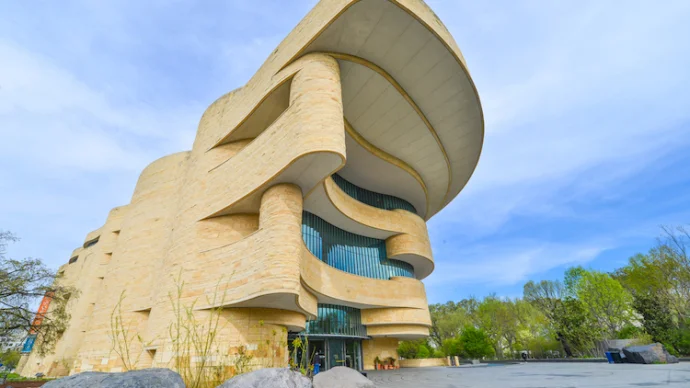
About National Museum of the American Indian – New York
The National Museum of the American Indian (NMAI) is dedicated to exploring the history and culture of indigenous Americans. Part of the Smithsonian Institution, the NMAI holds around a million artefacts spanning various tribes and periods of history from the Paleo-Indian to the present.
There are 2 main branches of the National Museum of the American Indian: one in Washington DC and the other in New York City.
National Museum of the American Indian – New York history
In 1989, the US States Senator Daniel Inouye passed the National Museum of the American Indian Act, establishing the NMAI as a living memorial to indigenous Americans. The act was the result of controversy when indigenous leaders discovered the Smithsonian Institution was holding between 12,000 to 18,000 indigenous remains in storage.
The act also required human remains, funeral objects and sacred objects be considered to be returned to the tribal communities, especially as some objects were acquired illegally. Since the 1989 legislation, the Smithsonian has repatriated over 5,000 individual remains – around a third of the total human remains in the collections.
Creating the museum also combined the collections of the Smithsonian and George Gustav Heye Centre in New York City in 1990. The growing collection needed a new building. After negotiations that saw the museum criticised for not being directed by indigenous staff and the Smithsonian wanting to relocate the collection to Washington DC, a compromise was made, and the museum was relocated within New York City to the Alexander Hamilton US Custom House in Manhattan.
The building was constructed between 1902 and 1907 by the federal government to house the duty collections for the Port of New York. Designed by Cass Gilbert, the neoclassical Beaux-Arts style customs house was later abandoned by the US Customs Service. In 1990, the building was renamed after Alexander Hamilton, one of the US’ founding fathers, and was repurposed as the George Gustav Heye Center of the National Museum of the American Indian in 1994.
National Museum of the American Indian – New York today
Today, visitors to New York City’s NMAI can access – without charge – the rich, deep and diverse collection of honestly presented indigenous cultures from throughout the Americas. In one of the ongoing exhibitions, ‘Infinity of Nations’, you can see objects representing each region including an Apsáalooke Crow robe and a detailed Mayan limestone relief.
A spectacular exhibition, ‘Ancestral Connections’, explores how 10 contemporary artists draw on their heritage and tribal history to create new artwork. After exploring the museum’s collections and exhibits, the customs house’s front steps are an ideal spot to pause, watch people go by and admire the tulips surrounding the square’s fountain.
Getting to the National Museum of the American Indian – New York
The best way of getting around the immense and bustling New York City is by subway: catch the Whitehall Street – South line to Ferry or Bowling Green, both a 2 minute walk from the NMAI. Alternately, bus lines M20, M55, QM7, QM8, QM11, QM25 and more stop at State St/Bridge St just outside the museum.
Featured In

Native American Museums
Discover the history of North America's Indigenous peoples at these 10 unmissable museums around the United States.




















